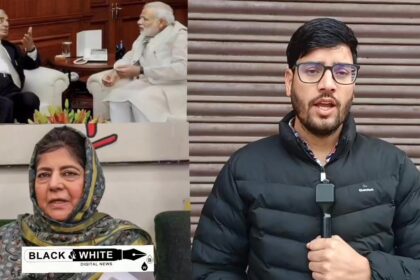No Time Limit or 60-km Exception: Roads Ministry Busts Myths Around Toll Collection on National Highways
Viral Video Sparks Clarifications on Toll Plaza Rules and Placement
||Black and White Digital News ||
||Parvinder Singh August 04,2024 ||
DELHI: Ministry of Road Transport and Highways (MoRTH) has clarified that there is no provision for exempting toll fees if the queue extends beyond a certain distance or time at National Highway (NH) toll plazas. Additionally, the ministry stated that toll plazas operating within a 60-kilometer range of each other are permissible under current regulations.
Clarifications in the Lok Sabha:
In two separate responses in the Lok Sabha, Union Minister Nitin Gadkari addressed concerns regarding the operation and placement of toll plazas. Saharanpur MP Imran Masood raised a query about commuters on the Chandigarh-Dehradun NH-73 being charged tolls at closely spaced plazas. Gadkari responded that such arrangements are allowed under the NH Fee Rules and the Concession Agreement, referencing a user fee notification from September 2020.
Viral Video and Misconceptions:
An old video of Gadkari from March 2022, in which he promised to ensure only one toll plaza within a 60-kilometer stretch, recently went viral. However, Gadkari’s recent reply in the Lok Sabha indicated no such exemption would be implemented. When Masood asked if the National Highways Authority of India (NHAI) would close the second toll plaza, Gadkari replied that the need “does not arise.”
Establishment of Toll Plazas:
Gadkari explained that toll plazas are established according to the National Highways Fee (Determination of Rates and Collection) Rules, 2008. These rules allow for toll plazas to be situated within 60 kilometers of each other if necessary, documented in writing. Toll plazas can also be set up within this range for the collection of fees for permanent bridges, bypasses, or tunnels. This distance criterion did not exist in the earlier 1997 rules.
No Exemption for Long Queues:
In response to Nagaur MP Hanuman Beniwal’s question about guidelines for lifting boom barriers if queues exceed 100 meters, Gadkari clarified that there is no provision for exempting vehicles from tolls due to long queues or waiting times. He noted that the mandatory implementation of FASTag has significantly reduced waiting times at toll plazas, from 734 seconds to 47 seconds as of the 2022 financial year.
Guidelines for Toll Plaza Operations:
While there is no toll exemption for long queues, the NHAI issued guidelines in May 2021 to minimize waiting times at toll plazas, ensuring a service time of no more than 10 seconds per vehicle even during peak hours. These guidelines also mandate that vehicles will be allowed to pass without paying toll if queues exceed 100 meters, and yellow lines will be marked to indicate this threshold.
Detailed Response to Parliamentary Queries:
Gadkari elaborated on several key points regarding toll collection and plaza placement in response to parliamentary queries. He reiterated that the establishment of toll plazas follows the National Highways Fee (Determination of Rates and Collection) Rules, 2008. These rules stipulate that additional toll plazas within the same direction on a highway section must not be less than 60 kilometers apart unless deemed necessary by the executing authority, which must document the reasons in writing.
Addressing Misinterpretations of Viral Video:
The resurfaced video from March 2022, where Gadkari mentioned shutting down additional toll plazas within a 60-kilometer range, created confusion among the public. However, the official stance clarified in the Lok Sabha negates the expectation of such exemptions, reinforcing that the operational guidelines as per the 2008 rules remain unchanged.
Specific Cases and Legislative Clarifications:
Gadkari specifically addressed the case of the Sarsawa toll plaza on the Chandigarh-Dehradun NH-73. He clarified that the toll collection at this plaza is conducted in accordance with the user fee notification dated September 22, 2020, which aligns with the provisions of the NH Fee Rules. This ensures that the toll plaza operates legally within the stipulated regulations, even if the distance between adjacent plazas is less than 60 kilometers.
Impact of FASTag Implementation:
Gadkari highlighted the success of FASTag in reducing wait times at toll plazas. Post the mandatory implementation on February 16, 2021, the average waiting time has drastically reduced, making the toll collection process more efficient. The Impact Assessment study conducted by the NHAI showed a significant reduction in average waiting time from 734 seconds to 47 seconds, underscoring the efficiency of the FASTag system.
NHAI Guidelines for Queue Management:
The May 2021 guidelines from the NHAI aim to ensure minimal waiting time at toll plazas, particularly during peak hours. The guidelines emphasize that service times should not exceed 10 seconds per vehicle. If queues extend beyond 100 meters, toll booths are instructed to lift boom barriers to allow free passage until the queue is reduced to within 100 meters. This is intended to facilitate a seamless flow of traffic and reduce congestion.
Accountability Measures for Toll Plaza Operators:
To enhance accountability, the guidelines require marking a yellow line 100 meters from the toll booth in each lane, indicating the threshold for free passage. This measure ensures that toll plaza operators maintain efficient service levels and prevent long queues from forming, thereby improving the overall user experience on national highways.
Ongoing Issues at Ban Toll Plaza, Nagrota
Despite these regulations, the Ban Toll Plaza at Nagrota has been plagued by long traffic jams and mismanagement. Daily commuters face significant delays due to a lack of supervision and monitoring by traffic police, with no accountability from the NHAI staff. Complaints of misbehavior by staff members are common, and the situation is exacerbated by VIPs enjoying free lane access, leaving regular commuters frustrated. The absence of proper management and accountability mechanisms has resulted in a chaotic toll collection environment, causing daily inconvenience to thousands of travelers.
The Ministry of Road Transport and Highways’ clarifications aim to dispel myths and provide clear, regulatory-backed explanations regarding the functioning of toll plazas on National Highways. The comprehensive responses in the Lok Sabha and the emphasis on FASTag implementation and queue management guidelines underscore the ministry’s commitment to efficient toll collection and minimal inconvenience for commuters.
*Video Courtesy Sansad TV*
Leave a comment
You Might Also Like
Ruhullah Mehdi K Kehne Se Desh Nahi Chalega Kyu Wande Matram Nhi Bologe BJP Spokesperson Thakur Abhijeet Jasrotia
Ruhullah Mehdi K Kehne Se Desh Nahi Chalega Kyu Wande Matram Nhi Bologe BJP Spokesperson Thakur Abhijeet Jasrotia #RuhullahMehdi #BJPSpokesperson…
0 Min Read
“Justice for Fire & Emergency Aspirants Will Come the Day Officers Who Took Bribes and Gave Jobs Are Removed Our
“Justice for Fire & Emergency Aspirants Will Come the Day Officers Who Took Bribes and Gave Jobs Are Removed Our…
0 Min Read
HC Bars 9% Vehicle Tax, But Alleged Defiance by RTO Kashmir Raises Rule-of-Law Concerns
HC Bars 9% Vehicle Tax, But Alleged Defiance by RTO Kashmir Raises Rule-of-Law Concerns ||Black and White Digital News ||…
4 Min Read
Mufti’s Alliance With BJP Was Misunderstood; It Was For The Sake Of J&K Mehbooba Mufti
Mufti's Alliance With BJP Was Misunderstood; It Was For The Sake Of J&K Mehbooba Mufti #MehboobaMufti #MuftiMohammadSayeed #PDP #BJPPDPAlliance #JammuAndKashmir…
0 Min Read









